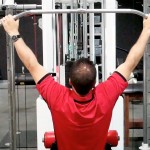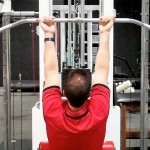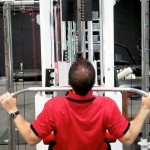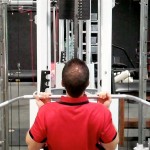Brian Schiff’s Blog
Injury Prevention, Sports Rehab & Performance Training Expert
As I write this update, I have now been back to work for a month. The first 3 days back were challenging, as I had not done that much with my arm in quite some time. I was sore by 5 pm each day, but no significant pain. The soreness resolved by the next morning. I quickly realized how weak I was as I attempted to stretch a client’s hamstring lifting the right leg up with my left arm.
With that said, going back to work also facilitated me moving the arm more frequently and using it against gravity. This has allowed me to regain more functional mobility and strength the past month. I have been careful to avoid any heavy or overhead lifting. I have not encountered something I could not do yet in patient care, but I have had to be aware of my body mechanics and positioning to reduce strain on the left arm.
MD follow-up
I saw the doctor this past Friday. He was pleased with my progress and encouraged me to keep working on regaining the last portion of my ROM. I will go back for one final appointment in 6 weeks. Of note, I had previously asked him to image the right shoulder to see if I had a tear since I have been having some right shoulder pain that has worsened since the left shoulder surgery. The MRI revealed a partial tear (30-40% of mostly bursal-sided fibers), some degeneration in the anterior labrum, biceps inflammation and a sizable bone spur. In essence, the doctor says I need to have the bone spur taken out in the near future to avoid a full tear on my right side. Not great news, but I am relieved it was not fully torn.
Rehab and Exercise
I am continuing to get stretched 2x/week, while doing my pulley and ROM exercises daily at home. I am performing scapular and rotator cuff strengthening about 3x/week. I returned to the gym for the first time on Labor Day. This was a humbling day to be sure as I cannot even do 50% of my previous weight with pull downs, rows and other lifts. But, Rome was not built in a day, and I know it will likely take up to a year to get back to 100% again.
Shoulder pain is one of the most common issues I treat in my clinic week to week, There are many causes of pain, but the most common cause of shoulder pain in active individuals typically involves the rotate cuff. These relatively small muscles are called upon to manage high and repetitive loads during sports, work and daily activity.
In some cases, there is just mild inflammation that does not limit function. In there cases, there is more acute pain that makes it hard to even raise the arm or use it for the most basic things. It can be difficult to really discern if there is significant injury as even acute tendinitis can be debilitating.
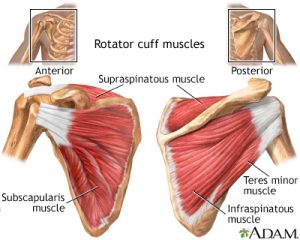
Image courtesy of Medline Plus
In a blog post I wrote for my work site, I discuss the differences between tendinitis, tendinosis and tears of the rotator cuff. Click here to read more.
If you have rotator cuff pain and are looking for a simple at-home rehab plan or injury prevention program, check out my training guide at www.rotatorcufftraining.com.
In the case of shoulder pain and dysfunction, the lower trapezius and serrates anterior are often implicated as part of the problem. Research has shown that these two muscles often fatigue and don’t contribute equally to the force couple between them and the upper trapezius that facilitates upward rotation of the scapula.
Building scapular stabilization and dynamic stability is a must for those doing repetitive overhead activities such as throwing, swimming, serving, or work-related tasks. It is a given that asymmetries will exist, so optimizing the strength of the rotator cuff and scapular stabilizers is paramount to prevent injury and recover from overuse syndromes.
To strengthen the lower trapezius, one of my ‘go to’ exercises is the lower trap raise. It can be done with just the weight of your arms or using light dumbbells. The link below includes the full description for the exercise, and I also embedded the video below.
http://fit-pro.com/article-4137-Lower-trap-raise.html
In the next column, I will include a serratus anterior exercise using a kettle bell as a follow-up to this post.
One of the most common issues I see in the clinic with active exercise enthusiasts between the age of 20 and 55 is shoulder pain. Weightlifting has been popular for ages, but Crossfit is all the rage these days. Both disciplines involve overhead lifts. The key thing to remember when performing overhead repetitive lifts is how load and stress not only affects strength and power, but how it impacts the joint itself.
Pull-ups and pull-downs are staples for most clients I see. As a therapist and strength coach, I am always thinking and analyzing how variables such as grip, grip width, arm position, scapular activation, trunk angles etc influence exercise and how force is absorbed by the body. One such exercise I have spent time studying and tweaking is the lat pull-down.
Consider for a moment how width and grip impacts the relative abduction and horizontal external rotation in the shoulder at the top and bottom of the movement in the pictures below (start and finish positions are vertically oriented):
It should be common knowledge for most, but I will state it for the record anyway – you should NEVER do behind the neck pull-downs. Beyond the horrible neck position, this places the shoulder in a dangerous position for impingement and excessively stresses the anterior shoulder capsule. A wider grip (be it with pull-ups, pull downs, push-ups) will always transfer more stress to the shoulder joint because you have a longer lever and greater abduction and horizontal external rotation.
So, what bearing does this have in relation to the rotator cuff and SLAP injuries? For more information and details on the application of the grip choice, click here to read the full column I did for PFP Magazine this month. Stay tuned for my next post (a follow-up to this one) one of my Crossfit patients who now only has pain with overhead squats and how my differential diagnosis and rehab has led me to conclude what is wrong with his shoulder. Keep in mind we must learn to train smarter so we can train harder and longer without pain and injury. Biomechanics and understanding your own body really does matter.
Ever feel the tightness or ache deep in the shoulder during or after a series of bench press sets? I must admit I LOVED doing bench press all through college and in my early twenties. Guys love the chest pump and of course nothing impresses a girl more than broad shoulders, a big chest and beefy arms, right?
Then as I began gaining years of experience as a therapist and started my personal training career, I began to realize a common scenario in men lifting weights regularly. They had horrible posture, weak posterior chain strength and sore shoulders. The common thread was this:
- Bench press and loads of chest exercises 2-3x/week and maybe some occasional back exercises thrown in once per week.
This repetitive bench pressing, dips and flies created a HUGE imbalance. Keep in mind for every chest exercise you do, you should balance it with a back exercise. Some believe the ratio of back to chest exercises should be 3:2, while others suggest 2:1. Suffice it to say I just believe we need less pressing and flies and more back exercises in general.
The poor weak rotator cuff stands up tall in the teens, twenties and early thirties, but it eventually starts to break down over time. Aside from modifying range of motion, load and changing arm angles (all things I preach), you must work hard to reverse the effects of gravity by doing more upper/lower back training to prevent the caveman syndrome.
Your long term shoulder health depends on it. I have rehabbed hundreds of shoulders going through rotator cuff and labral repair that are no doubt in some way related to lifting abuse. Take my word for it when I tell you backing off the load, volume and frequency of bench pressing will add years of life to your shoulders and prevent you from living on anti-inflammatory medication to make it through the day. I am not anti-bench per se, but I do believe once per week is more than enough for most of us.
Today, I have included a link to a recent column I wrote for PFP Magazine on one such posterior chain exercise to work the upper back and cuff. Click here to read the column.
In addition, I added a video of the exercise below. This is easy to do and will immediately improve shoulder health. Consider adding it to your gym routine at least 2x/week on upper body days.
In closing today, I want to wish all of my friends, family, subscribers and followers a Happy Holiday Season!

